Evaluating And Managing Risk Factors Related To Cardiovascular Disease In Vietnam
- Country :
Australia
Introduction and background
Cardiovascular disease is a disease that includes vascular and heart-related disease either in the brain, chest or blood vessels. Per year around 17.3 million individuals die around the world due to CVD. This disease is mainly found in middle to low-income countries. The surprising fact is that around 80% of the entire population with CVD originated from these countries. It is seen that premature deaths due to cardiovascular disease is nearly 42%. It includes around 3 million deaths that have occurred before 60 years of age and out of these patients most of the individuals might be prevented (Nguyen-Thi et al., 2021). Lifelong creation of atherosclerosis causes non-fatal and fatal cardiovascular diseases like cerebra vascular disease, cardiovascular disease, aortic disease and vascular disease. These are several factors that cause cardiovascular disease and contribute to the risk factors such as hypertension, diabetes, current smoking, lack of physical activity, abdominal obesity, lack of fruit-based diet, psychological stress, alcohol consumption and other cardiac causes.
Moreover, in Vietnam, there is a growing population and mortality rate for non-communicable and communicable diseases. There are an increasingly ageing population and the longevity of these diseases that are causing financial burden and death rates (Truong et al., 2022). Considering this, the present research paper is going to find out the risk factors related to cardiovascular disease in Vietnam.
Aims and purpose
The aim of this research paper is to identify different cardiovascular risk factors, their patterns and their impact on the health interventions of a community in Vietnam. The ultimate goal is to contribute to the optimisation and development of futuristic community-based cardio vascular disease-related health interventions so that they can be consecutively reduced the emerging burden of this epidemic in Vietnam. The purposes of this study are-
- To identify the cardiovascular risk factors and their patterns in the adult population in general in Vietnam.
- To identify the mitigation strategies for all these risk factors so that the rate of cardiovascular disease can be addressed to a certain extent in Vietnam.
A PICO approach can be designed to clearly demonstrate the aims and purpose of this research paper.
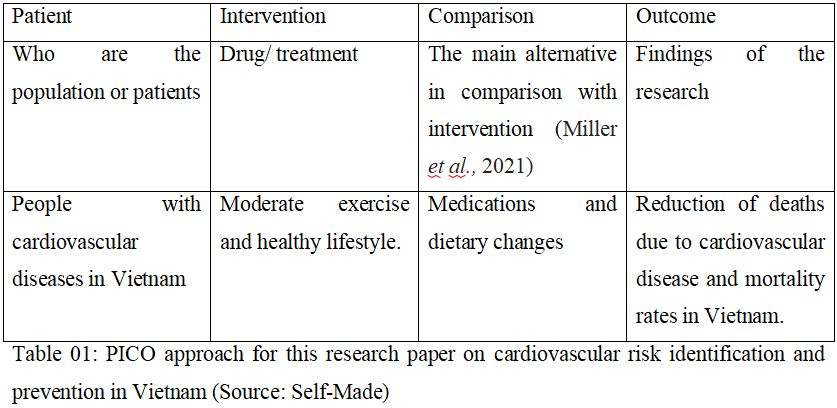
Method
Search strategy
A positivist philosophy will be adopted by the researcher as this strategy helps to develop huge rages of data that are basically based on the theories and literature in the existing articles ad research papers. A deductive research approach will be adopted by the researcher as new theories and concepts will be developed by the researcher using previous literature resources. The collection of huge data from the articles will support the existing resources (Olabode, Olateju and Bakare, 2019). A descriptive research approach will be adopted by the researcher as this method allows an individual to describe the positive and negative aspects of the research topic. As there are pre-determined research purposes and aims, the researcher will use a descriptive research method. For the sampling strategy, the researcher will use a randomised non-probability technique is adopted by the researcher. In this regard, 10 scholarly articles from recent year ate selected as a sample size (Brogan, Hasson and McIlfatrick, 2019). For the research strategy, qualitative research will be conducted by the researcher. The researcher will review the articles that pre-existed based on the topic to execute a secondary data collection method. For the analysis of the data, a qualitative analysis will be executed by the researcher. For ethical consideration, the researcher will properly cite the used articles to mitigate any kind of copyright risks (Haydon, Browne and van der Riet, 2018). Moreover, the gathered data will be unaltered so that the quality and authenticity of the research outcomes can be maintained.
Quality appraisal tools
CASP or Critical Appraisal Skills Program is considered the most effective tool that appraises the quality of health-related study of qualitative analysis. This tool is used to improve and support futuristic appraisal activities. It helps to appraise the limitations and strengths of a qualitative research study it further helps in reviewing the evidence of discussing a topic that is identified, summarised and appraised systematically as per the pre-considered criteria. It enables the assessment of relevance, trustworthiness and outputs of pre-published articles and papers in a systematic manner to maintain the quality of the search strategy (Long, French and Brooks, 2020). This CASP tool will help the researcher to maintain the quality of the research based on tent different questions. It helps to find out if there are clear and transparent research aims and objectives. It also helps to evaluate the appropriateness of the qualitative research methodology. It helps the researcher to analyse if the selected research design can effectively address the aims and objectives of the research or not (Crivelli et al., 2018). The appropriateness of the recruitment strategy is also analysed as per the research aims. It further evaluates the appropriateness of the data collection tool (qualitative tool) that is used for analysing the gathered data. The relationship between the researcher and the sample size needs to be adequately considered with this tool. Any ethical issues are there in the research paper are analysed (Purssell, 2020). It further analyses if the data analysis rigorous is there is a clear findings statement or not. lastly, it evaluates the value of the research.
Flowchart for literature review
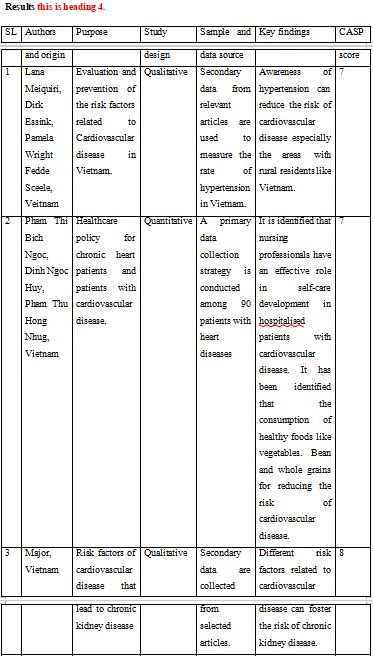
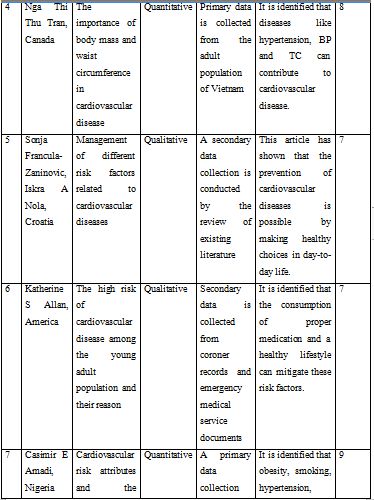
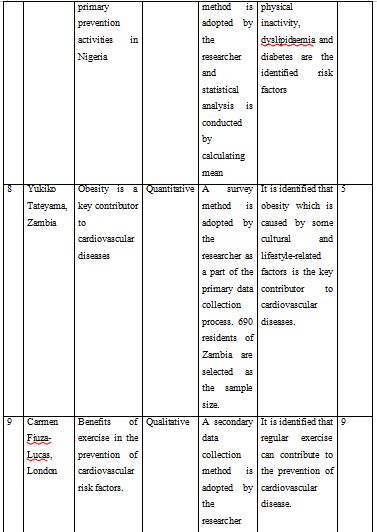
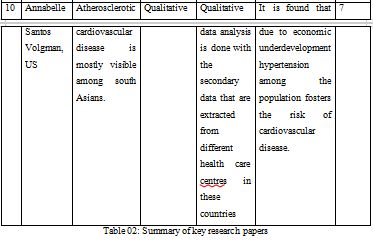
Key findings
Key findings include different day-to-day activities that can reduce the impact of cardiovascular disease. In this aspect, it is found that doing regular physical exercise, taking proper medication and taking a proper diet can reduce the risk of cardiovascular diseases and its adverse impact. In addition to that leaving smoking, alcohol and unhealthy diet can also reduce the risk factors related to cardiovascular diseases.
Discussion
Summary of the articles
The first research article demonstrated hypertension prevalence in Vietnam. The researcher has stated that there is no up-to-date evidence assessment id found regarding the hypertension magnitude in Vietnam. In this regard, the researcher has reviewed grey literature and scientific evidence to identify the records of hypertension which is the main contributor to cardiovascular disease. A quality assessment and eligibility screening are considered by the researcher. The data that is extracted from secondary resources have shown that there is a high rate of hypertension among the population of Vietnam that is causing different cardiovascular diseases (Ngoc, Huy and Nhung, 2021). Another article demonstrates how a specific healthcare policy for individuals with cardiovascular disease and chronic heart disease is required. In this regard, it is evidentially shown that self-care knowledge must be developed among the patients. This study shows that without proper self-care knowledge through educational interventions, populations with heart diseases fail to identify the major risk factors or contribute to cardiovascular disease and the result of educational intervention regarding self-care includes regular exercise, fruit-based diet, proper medication the before scenario (Major et al., 2018). Another research paper shows that WC or Waist Circumference is the main indicator of the tissue of abdominal adipose. The high level of this factor can contribute to the risk factors of cardiovascular diseases. This is the biological study that includes the relationship of cardiovascular diseases with the TC or total cholesterol and BP or blood pressure. The researcher conducted a quantitative analysis here (Tran et al., 2018). Another study states that there are several risk factors for cardiovascular disease that are related to day-to-day practices. The result shows that 'prevention is better than cure which means with the adoption of a healthy lifestyle and some changes in day-to-day activities can decrease the risk of cardiovascular diseases (Volgman et al., 2018).
Another research study is conducted in the Toronto area to understand the high prevalence of unexpected cardiovascular diseases among the young populations of that area. This research study shows that young people as also faced sudden cardiac arrest. It is identified that Greater Toronto Area is a highly populated city with 6.6 million individuals. Only 2 to 45 years of age group has been considered by the researcher to understand the reasons for out-of-hospital sudden cardiac arrest rates and causes. It shows that high alcohol consumption and smoking is the main contributor to this aspect (Francula-Zaninovic and Nola, 2018). A Nigeria-based study is conducted by a researcher to identify the risk factors of cardiovascular disease and the primary prevention activities. A cross-sectional study has been conducted. In this regard, the researcher has identified that the involvement and engagement of community pharmacists are required to mitigate the CVD risk factors (Allan et al., 2019). Another study shows that obesity among the rural population main Zambia is the main contributor to cardiovascular disease. It is identified that due to changes in lifestyle at a rapid rate, obesity and overweight among the rural population is the main contributor to developing cardiovascular diseases. In the recommendation part, the researcher has stated that regular physical exercise can reduce the risk of cardiovascular diseases among Zambian people (Amadi et al., 2018). Another research paper also has shown that to manage and prevent cardiovascular disease, physical activities on a regular basis is a highly appreciate and prevalent measure globally (Tateyama et al., 2018). Lastly, an article has identified atherosclerotic cardiovascular and heart-related health issues. This study evaluated the south Asians like the population from India, Bhutan, Bangladesh, Maldives, Sri Lanka and Pakistan to identify how low economic condition has contributed to hypertension among the population of these countries (Fiuza-Luces et al., 2018).
Common themes
The common themes among these identified articles are that in the prevention strategy most researcher has discussed the importance of physical exercise in addressing the risk factors related to cardiovascular diseases. It is identified that most of this literature is mainly based on the qualitative systematic analysis of the secondary research. Although there are some research papers that adopted a quantitative technique (Meiqari et al., 2019). Moreover, most of these researches are conducted in comparatively underdeveloped economic countries to find the similarity with Vietnam.
Limitations in the literature review
None of this literature has identified how lack of proper diet and diabetes are also the key root causes of cardiovascular diseases. This research gap has formulated a research opportunity for the researcher. Moreover, the effective use of medication can also address cardiovascular disease both in the hospital and out-of-the-hospital cases. All these factors have created gaps in the literature review as identified by the researcher of this current topic.
Recommendations
For future work, futuristic researchers are recommended to use quantitative analysis for the analysis of data. It is further recommended that future research must be executed in a way that can add value to the other existing literature. The researchers have to provide opportunities to the community and other researchers that can include a beneficial aspect in the conducted research. The researchers must provide an in-depth understanding of the research topic so that the readers and the scholars can develop a create an understanding of cardiovascular disease and its prevention strategies. It will help to decrease the rate of patients with cardiovascular diseases in a global context. Moreover, the parameters of this research can be used by futuristic researchers so that they can develop different perspectives in a similar field of research.
Are you struggling to keep up with the demands of your academic journey? Don't worry, we've got your back! Exam Question Bank is your trusted partner in achieving academic excellence for all kind of technical and non-technical subjects.
Our comprehensive range of academic services is designed to cater to students at every level. Whether you're a high school student, a college undergraduate, or pursuing advanced studies, we have the expertise and resources to support you.
To connect with expert and ask your query click here Exam Question Bank

